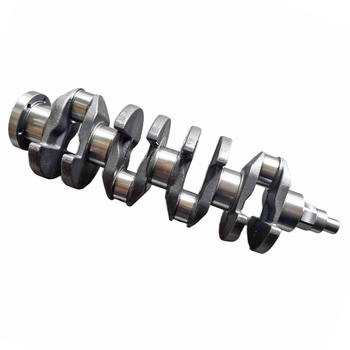The Unseen Challenges of Crankshafts
Have you ever wondered why engine crankshafts fail, despite being manufactured with high-quality materials? The answer lies in their complex design and the immense stress they endure. Fatigue life is a critical factor determining the durability and reliability of crankshafts. And as it turns out, fillet rolling and surface hardening can significantly enhance this aspect.
Understanding Fatigue Life
Fatigue life refers to the number of stress cycles a component can withstand before failure. In the case of crankshafts, factors such as material properties, design, and manufacturing processes directly impact their fatigue life. Interestingly enough, failure often occurs not due to a single catastrophic event but rather gradual wear and tear.
The Role of Fillet Rolling in Enhancing Fatigue Life
Fillet rolling is a process that improves the geometry of the crankshaft's fillets – the curved transitions between the journal and the web. By doing so, it reduces stress concentration, which contributes to enhanced fatigue life. But how exactly does this work?
Reshaping the Fillets
In my experience, fillet rolling involves using a specially designed roller to cold-work the surface of the fillet. This process effectively reshapes the fillet, increasing its radius and reducing the stress concentration factor. By minimizing peak stresses, we can significantly extend the crankshaft's fatigue life.
Surface Hardening: A Complementary Approach
While fillet rolling addresses the geometry of the fillets, surface hardening focuses on improving the material properties of the crankshaft surface. This technique involves subjecting the surface to a heat treatment process that increases its hardness and wear resistance. As a result, the treated surface becomes more resilient against fatigue, further enhancing the crankshaft's overall durability.
Popular Surface Hardening Techniques
There are various surface hardening techniques available, including induction hardening, nitriding, and carburizing. Each method has its unique advantages and applications, and selecting the appropriate technique depends on factors such as the base material, desired hardness, and production volume.
Practical Applications and Examples
So, how do these techniques translate into real-world benefits? Many experts agree that fillet rolling and surface hardening can significantly improve engine performance and longevity. For instance, in the automotive industry, implementing these processes can lead to reduced warranty claims and increased customer satisfaction.
- Case Study 1: A major automotive manufacturer adopted fillet rolling and surface hardening techniques for their engine crankshafts, resulting in a 50% reduction in warranty claims related to crankshaft failures.
- Case Study 2: A heavy-duty equipment manufacturer incorporated these processes into their production line, leading to an estimated 30% increase in crankshaft fatigue life.
How Our Company Can Help
At our company, we specialize in providing high-quality fillet rolling and surface hardening solutions tailored to your specific needs. Our team of experts can guide you through the entire process, from material selection to process optimization, ensuring optimal results and minimal downtime.
For more detailed information, please visit our official website: https://www.obfe.cn
Conclusion
In conclusion, fillet rolling and surface hardening are powerful techniques that can significantly enhance crankshaft fatigue life, ultimately leading to improved engine performance and reliability. By understanding the principles behind these processes and their practical applications, you can make informed decisions when it comes to selecting the right solutions for your specific requirements.




